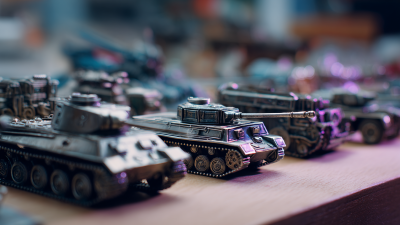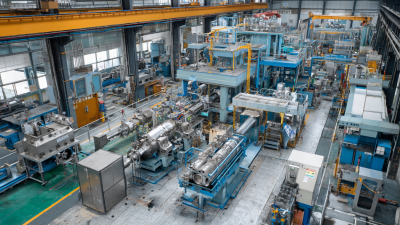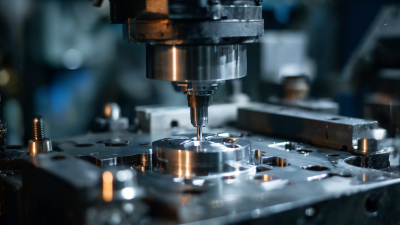Ultimate Guide to Mastering Die Cast Tooling for Efficient Production
In the ever-evolving landscape of manufacturing, mastering die cast tooling has become essential for companies aiming to optimize production efficiency and quality. The global die casting market is projected to reach USD 87.54 billion by 2026, growing at a CAGR of 7.9% from 2021, as industries increasingly rely on lightweight and durable components for applications in automotive, aerospace, and consumer goods. Effective die cast tooling not only enhances productivity but also ensures precision in creating complex geometries, which is crucial in meeting the stringent demands of today's market. According to a recent study by Research and Markets, up to 75% of manufacturers are adopting advanced die casting techniques to reduce lead times and improve cost efficiency. Therefore, understanding the fundamentals and innovations in die cast tooling is imperative to stay competitive and drive business growth in this dynamic environment.

Understanding Die Cast Tooling: Key Concepts and Terminology
Die cast tooling is a critical aspect of the manufacturing process, particularly when it comes to producing high-quality metal parts efficiently. Understanding key concepts and terminology associated with die casting is essential for achieving optimal production results. A die is essentially a mold used to shape molten metal, and the tooling refers to the equipment and processes involved in creating that die. Key terms such as “gate,” “runner,” and “vent” will become foundational as you delve deeper into die casting processes. These components play vital roles in ensuring the molten metal flows correctly and cools properly to form high-precision parts.
Tips for effective die cast tooling include investing in quality materials for your dies, as they significantly affect the longevity and accuracy of your production. Regular maintenance and inspection of tooling can prevent downtime and costly repairs, making your production process smoother. Additionally, leveraging computer-aided design (CAD) software can help visualize and optimize your tooling design before production, leading to better outcomes and minimized errors during the casting process. Understanding these key concepts and implementing proven strategies can propel your die cast production efficiency to new heights.

Selecting the Right Materials for Die Cast Tooling Efficiency
Selecting the right materials for die cast tooling is crucial for enhancing efficiency in production processes. As the die casting industry evolves, manufacturers are increasingly focusing on advanced lightweight materials that not only improve production speed but also reduce costs. For instance, the incorporation of high-strength alloys and advanced plastics can lead to more durable and innovative tooling designs, enabling manufacturers to produce parts with thinner walls while maintaining structural integrity.
Sustainability is also becoming a key consideration in material selection for die cast tooling. Emphasizing the use of non-hazardous materials and advanced reclamation technologies can offer significant benefits. These practices not only enhance the environmental footprint of the production process but also pave the way for a more cost-effective operation. By making intentional choices regarding material types and sourcing, companies can establish a competitive edge in the fast-changing landscape of manufacturing, ultimately aligning their processes with modern sustainability metrics and consumer expectations.
Ultimate Guide to Mastering Die Cast Tooling for Efficient Production - Selecting the Right Materials for Die Cast Tooling Efficiency
| Material Type | Properties | Cost per Kg | Best Applications | Production Efficiency |
|---|---|---|---|---|
| Aluminum Alloys | Lightweight, corrosion-resistant, good thermal conductivity | $2.40 | Automotive parts, consumer electronics | High |
| Zinc Alloys | Low melting point, excellent fluidity, good dimensional stability | $1.50 | Hardware, toys, small precision components | Medium |
| Magnesium Alloys | Very lightweight, good strength-to-weight ratio | $3.00 | Aerospace applications, automotive components | High |
| Copper Alloys | Excellent electrical conductivity, good machinability | $6.00 | Electrical connectors, heat exchangers | Medium |
| Steel Alloys | Highly durable, good tensile strength, heat resistant | $2.50 | Heavy machinery, automotive frames | Medium to Low |
Optimizing Design for Enhanced Die Cast Tooling Performance
When it comes to die casting, optimizing design is crucial for enhancing tooling performance and achieving efficient production. According to a report by the Global Die Casting market, companies that invest in advanced tooling designs can improve cycle times by up to 30%. This increase in efficiency not only reduces costs but also allows manufacturers to meet growing consumer demands more effectively.
Another critical aspect of optimizing die cast tooling design involves material selection. A study by the Aluminum Association highlighted that using high-performance alloys can significantly enhance the durability and lifespan of die cast components, leading to fewer tool changes and reduced maintenance costs. By focusing on precision engineering and incorporating advanced simulation technologies, manufacturers can identify potential flaws in the design phase, thereby increasing the overall quality and performance of their die cast tools.
Moreover, integrating smart manufacturing technologies into the design process can further drive efficiency. Recent findings from the Manufacturing Institute indicate that companies embracing Industry 4.0 solutions see a 20% reduction in production costs while enhancing product quality. This trend underscores the value of innovative design practices in die cast tooling, setting a foundation for sustainable growth in production capabilities.
Best Practices for Maintenance and Care of Die Cast Tools
Proper maintenance and care of die cast tools is essential for ensuring high productivity and longevity in manufacturing processes. The first step in maintaining these tools is regular cleaning to prevent the buildup of molten metal and other contaminants. Using appropriate solvents and brushing techniques can help keep the surfaces smooth and prevent defects in the die cast parts. Additionally, inspecting the tools for wear and tear after each production cycle can help identify issues before they turn into costly repairs.
Another best practice is to implement a consistent lubrication schedule. Lubricating the moving parts of the tooling reduces friction, which not only extends the lifespan of the tools but also improves the quality of the final product. Using the manufacturer’s recommended lubricants ensures compatibility and effectiveness. Furthermore, maintaining optimal operating temperatures is crucial; overheating can cause significant damage. Incorporating temperature monitoring systems in the production line can help maintain the proper operating conditions and prevent overheating.
Lastly, training operators in the proper handling of die cast tools is vital. Educating personnel on the importance of care and maintenance, along with the correct procedures, can mitigate risks of damage and extend the tools’ lifespan. By prioritizing these best practices, manufacturers can significantly enhance productivity and reduce downtime in their die casting operations.

Innovative Technologies Transforming Die Cast Tooling Processes
The die casting industry is experiencing a significant transformation driven by innovative technologies that enhance tooling processes. Recent reports indicate that advanced manufacturing techniques, such as additive manufacturing and artificial intelligence, are reshaping the landscape of die cast tooling. According to a study by MarketsandMarkets, the global die casting market is projected to reach $109.5 billion by 2025, fueled by the adoption of automation and sophisticated tooling solutions. These advancements not only improve production efficiency but also reduce lead times by up to 20%, allowing manufacturers to meet the growing demand for high-quality components.
One key innovation in die cast tooling is the integration of simulation software, which enables businesses to test and optimize tooling designs before physical production begins. This technology can reduce tooling costs by as much as 25%, as it minimizes the need for multiple prototypes. Additionally, the rise of IoT connected systems is enhancing real-time monitoring and predictive maintenance of die casting equipment, further driving down downtime and increasing operational efficiency. As these technologies continue to evolve, they are setting new industry benchmarks for quality, speed, and sustainability in die casting operations.
Efficiency in Die Cast Tooling Processes Over Time
Related Posts
-

How to Choose the Best Die Cast Die for Your Manufacturing Needs
-

Top 5 Innovative Die Cast Equipment Examples Revolutionizing Manufacturing Efficiency
-

Best Die Cast Solutions: Enhancing Precision and Efficiency in Manufacturing
-

The Future of Die Casting: Innovations Shaping Tomorrow's Manufacturing
-

10 Insights for Mastering Die Cast Plastic Techniques
-

How to Optimize Your Die Mold Production Process for Maximum Efficiency
Copyright © 2025 · All Rights Reserved · Franchino Mold & Engineering
